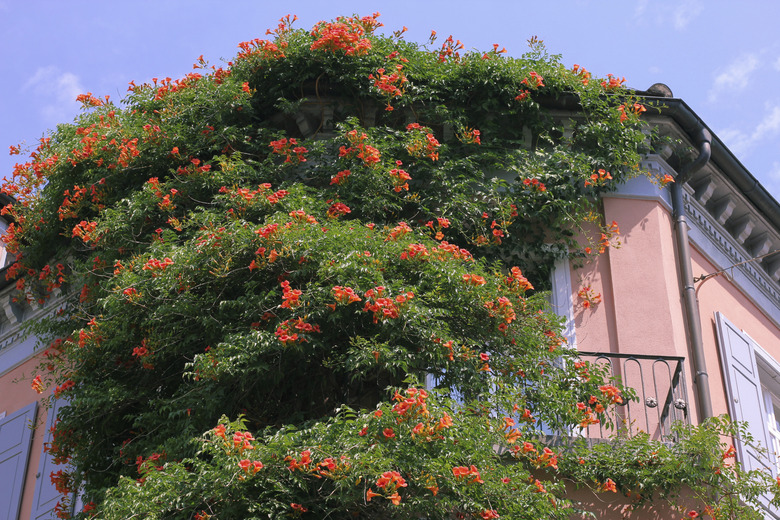How To Prune Trumpet Vines
Trumpet vine (Campsis radicans) is spectacular but once this aggressive grower gets out of hand, its unrestrained growth can be downright destructive. In addition, its sap can irritate skin, causing a rash for some and it is mildly toxic if eaten.
Trumpet vine (Campsis radicans) is spectacular but once this aggressive grower gets out of hand, its unrestrained growth can be downright destructive. In addition, its sap can irritate skin, causing a rash for some and it is mildly toxic if eaten. You'll need sharp hand shears, a lopper and a sharp garden spade, long sleeves and gloves to groom your trumpet vine. And keep the kids and dogs indoors until you've cleaned up every twig.
What to Prune
A trumpet vine requires two or three years to establish itself and start blooming. Prune weaker branches off from young vines to leave one main stem and branches that cover your trellis or wall. When the vine matures, cut the flowering shoots that have grown away from the supported branches back to the main branches in early or late winter. These branches will regrow the next year.
- Trumpet vine (Campsis radicans) is spectacular but once this aggressive grower gets out of hand, its unrestrained growth can be downright destructive.
- Prune weaker branches off from young vines to leave one main stem and branches that cover your trellis or wall.
Use hand shears to trim and loppers to extend your reach or cut branches thicker than 1/4 inch. Cut back branches that grow into gutters or the roof. Remove suckers by forcing a garden spade across the sucker underground. Wipe tools frequently with a solution of equal parts rubbing alcohol and water or hand sanitizer.
When to Prune
Ill-timed trimming can leave you with few or no flowers the next season. In U.S. Department of Agriculture plant hardiness zones 4 through 6, prune a trumpet vine in late winter when average daytime temperatures begin to rise above freezing, usually from February through March. In USDA zones 7 through 9, prune a trumpet vine after the flowers fade in fall, from October through November. Take suckers and pinch back overgrown growing tips whenever they appear from spring through summer. Whenever you prune, wear long sleeves, long pants, gloves and eye protection.
- Use hand shears to trim and loppers to extend your reach or cut branches thicker than 1/4 inch.
- Take suckers and pinch back overgrown growing tips whenever they appear from spring through summer.
Simplify the Job
Position your vines for success. Trumpet vines climb by sinking strong, intrusive aerial roots, so grow them on wood or metal trellises that stand 4 to 6 inches away from siding, delaminated stucco, ventilation panels and cracked mortar that they could pry loose. Cut back an old branch or two every year to maintain control. And when a trumpet vine outflanks you and grows too large and ungainly, cut it to within 12 inches of the ground in late winter to renovate it. Begin training the strongest new shoots to the trellis in spring.
Choosing a Trumpet Vine
Some trumpet vines are considered invasive in some areas, so check before planting. Common trumpet vine, which grows in USDA zones 4 through 9, grows to 40 feet.
- Position your vines for success.
- Trumpet vines climb by sinking strong, intrusive aerial roots, so grow them on wood or metal trellises that stand 4 to 6 inches away from siding, delaminated stucco, ventilation panels and cracked mortar that they could pry loose.
Chinese trumpet vine (Campsis grandifora), which grows in USDA zones 6 through 9, tops out at 30 feet. Trumpet creeper (Campsis x tagliabuana), which grows in USDA zones 5 through 9, is a hybrid between the common and Chinese varieties that grows 15 to 25 feet tall.
Common trumpet vine blooms from the first hot weather in July through early fall in September. The hybrid creeper follows in August and the Chinese vine follows later in August.
References
- Missouri Botanical Garden: Campsis Radicans
- Missouri Botanical Garden: Campsis Grandiflora
- Missouri Botanical Garden: Campsis x Tagliabuana
- University of Missouri Extension: Selecting Landscape Ornamental Vines
- National Gardening Association: Trumpet Vine
- Royal Horticultural Society: Campsis
- University of Illinois Extension: Invasive vs. Aggressive
- University of Illinois Extension: Vines on Buildings
